常用英语8种时态标志词
8种时态标志词

2
1、一般现在时 表示:现阶段经常发生的动作或存在的状态
We _g_o__ ( go) to school at six forty every day.
My brother _r_e_a_d_s ( read) a book once a week.
一般现在时使用注意事项:
He will be happy when he h__e_a_r_s_ ( hear ) the good news . Tell me when he __w__il_l__a_r_r_iv_e___ (arrive ).
I don’t know if he __w_i_l_l _c_o_m__e__ (come).
11. Dinosaurs _d_i_s_a_p_p_e_a_r_e_d_ (disappear) about 65
million years ago.
12. They _w_e_r_e__a_s_k_e_d_ (ask) to help the farmers
with the harvest last autumn.
He has given up drinking .
( 现在已经不喝酒了)
He gave up drinking last month .
(只说明上个月戒了酒,现在喝不喝酒不知道。)
7. 现在完成进行时 动词形态:have / has been + doing
用法
例句
We have been studying English for three 继 years . --- 现在仍在学 续 He has been reading since this morning .
英语时态标志词

动词时态标志词1.一般现在时(1) always, usually, often, sometimes(2) every day, every morning, every Saturday, every time(3) in the morning, on Saturdays(4) once a week,(每周一次) three times(三次),a day, twice a year (一年两次)2.一般过去时(1) yesterday, the day before yesterday,(前天)yesterday morning /evening/afternoon)(2) last time, last Friday,last term,上学期 last month上个月(3) 2 hours ago两小时前 a week ago一周前 3 years ago (4) just now = a moment ago刚刚(5)in 1989(6)at the age of 5,(5岁) one day,long long ago很久很久以前,once upon a time曾经(7) in the past在过去3.现在进行时(1).now. Look. Listen.(2).these days(这些天)(3).at that time = at that moment. 此时此刻this time,ringht now(正在)4.过去进行时(1).at that time====at that moment.那时那刻this time ,yesterday evening(2)以when引导的谓语动词是一般过去时的时间状语5.一般将来时(1) tomorrow, in the future在将来 some day不久的一天the day after tomorrow,后天tomorrow morning /evening/ afternoon(2) next time, next Friday, next term, next month(3) in two weeks/monthes/years两周/月/年后(4) soon = right away = at once不久(5) by the end of + 将来时间直到。
英语常见时态标志词语

1现在完成时的词语标志,遇到这样的词一般用完成时2一些其他时态的标志词语现为你提供如下八种时态常用的标志词。
1、一般现在时表示:现阶段经常发生的动作或存在的状态标志: often、usually、always、sometimes、every day、in the morning (afternoon …)、on Sundays, once a week等例子:We go to school at six forty every day.My brother reads a book once a week.2、一般将来时表示:将要发生的动作或存在的状态标志:tomorrow、next week、this month、in an hour、the day after tomorrow 等例子:He will go to see a doctor tomorrow.I am going to play basketball next week..She is coming back in an hour.3、一般过去时表示:过去发生的动作或存在的状态标志: yesterday、last week、three days ago、the day before yesterday, in 1990 等例子:I finished my work yesterday.He went to New York ten days ago.4、现在进行时表示:现在正在进行的动作标志:now、Look! Listen! It’s six o’clock..例子:Look! The boy is playing with a cat.It’s eight o’clock . The Smiths are watching TV in the living room.5、过去进行时表示:过去某个时刻正在进行的动作标志:at six yesterday morning、from 7 to 9 yesterday morning 、this time yesterday、也可用在when和while引导的从句例子: He was taking a shower at 11 last night .They were cooking when the bell rang.(= While they were cooking, the bell rang.)6、现在完成时结构: have / has + 动词过去分词(一般+ed , 特殊见不规则表)表示:1)表示过去发生或完成的某一动作对现在造成的影响或结果。
时态标志词

山大之星培训中心英语八种时态归纳复习英语八种时态归纳复习一、一般现在时:概念:经常、反复发生的动作或行为及现在的某种状况。
时间状语:always, usually, often, sometimes, every week (day, year, month…), once a week, on Sundays, etc.二、一般过去时:概念:过去某个时间里发生的动作或状态;过去习惯性、经常性的动作、行为。
时间状语:ago, yesterday, the day before yesterday, last week(year, night, month…), in 1989, just now, at the age of 5, one day, long long ago, once upon a time, etc.三、现在进行时:概念:表示现阶段或说话时正在进行的动作及行为。
时间状语:now, at this time, these days, etc.四、过去进行时:概念:表示过去某段时间或某一时刻正在发生或进行的行为或动作。
时间状语:at this time yesterday, at that time或以when引导的谓语动词是一般过去时的时间状语等。
五、现在完成时:概念:过去发生或已经完成的动作对现在造成的影响或结果,或从过去已经开始,持续到现在的动作或状态。
时间状语:recently, lately, in the past few years, already, yet, just, ever, never ,so far, for +一段时间,since+过去的时间或过去时从句.或this year alone"今年以来",these five years alone"这五年以来",in the last ten years "在过去的十年中"等.etc.六、过去完成时:概念:以过去某个时间为标准,在此以前发生的动作或行为,或在过去某动作之前完成的行为,即“过去的过去”。
英语八大时态标志词及结构表
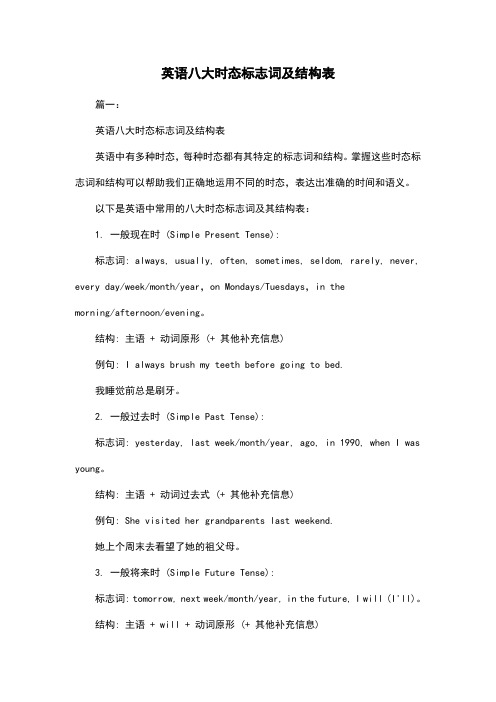
英语八大时态标志词及结构表篇一:英语八大时态标志词及结构表英语中有多种时态,每种时态都有其特定的标志词和结构。
掌握这些时态标志词和结构可以帮助我们正确地运用不同的时态,表达出准确的时间和语义。
以下是英语中常用的八大时态标志词及其结构表:1. 一般现在时 (Simple Present Tense):标志词: always, usually, often, sometimes, seldom, rarely, never, every day/week/month/year,on Mondays/Tuesdays,in themorning/afternoon/evening。
结构: 主语 + 动词原形 (+ 其他补充信息)例句: I always brush my teeth before going to bed.我睡觉前总是刷牙。
2. 一般过去时 (Simple Past Tense):标志词: yesterday, last week/month/year, ago, in 1990, when I was young。
结构: 主语 + 动词过去式 (+ 其他补充信息)例句: She visited her grandparents last weekend.她上个周末去看望了她的祖父母。
3. 一般将来时 (Simple Future Tense):标志词: tomorrow, next week/month/year, in the future, I will (I'll)。
结构: 主语 + will + 动词原形 (+ 其他补充信息)例句: We will go shopping tomorrow.我们明天去购物。
4. 现在进行时 (Present Continuous Tense):标志词: now, at the moment, currently, right now, look!。
常见八种时态标志词课件

现在进行时
现在进行时表示正在进行的动作 或存在的状态。
现在进行时的标志词包括“正在 ”、“正在”、“正在”、“正
在”等。
现在进行时可以用于描述正在发 生的事情、描述正在进行的动作
、表达正在存在的状态等。
现在完成时
现在完成时表示过去发生的动作 或状态对现在造成的影响或结果
。
现在完成时的标志词包括“已经 ”、“了”、“过”、“完成”
示例
By next year, we will have been studying English for three years.(到明年 ,我们将已经学了三年英语。)
将来完成进行时的用法
表示在将来某一时间之前已经开始的动作,并持续到将来某一时间。
表示在将来某一时间之前已经完成的动作,并对将来产生某种结果或影 响。
用法二
表示在过去的某个时间点之前,已经计划或安排好的事情,实际上 已经完成并进行了一段时间。
用法三
表示在过去的某个时间点,预计将会完成并进行一段时间的事情, 但实际上这个计划或安排被中断了。
THANKS FOR WATCHING
感谢您的观看
例句
Before I arrived, the meeting had already begun.
03
将来时态
将来时态概述
定义
表示将来某个时间将要发生的动 作或存在的状态
构成
基本结构是“助动词will/shall + 动词原形”
用法
常与表示将来的时间状语连用,如 tomorrow, next week, in 2023等
时间点
通常指过去的某个时间点,如 昨天、上周、去年等。
构成
八大时态的标志词
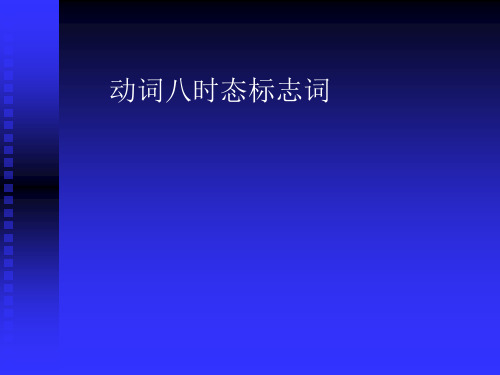
2)last time, last Friday, last term, last month
(3)2 hours ago, a week ago, 3 years ago
4)just now = a moment ago
一般现在时
(1)always, usually, often, sometimes
(3)in 2 hours, in a week, in 3 years' time, in a minute / monent
(4)soon = right away = at once
一般过去时
1)yesterday, the day before yesterday, yesterday morning
过去进行时
1.at that time.at that moment.this time yesterday evening
此课件下载可自行编辑修改,供参考! 感谢您的支持,我们努力做得更好!
动词八时态标志词
1、一般将来时 2、一般现
在时
3、现在进行时
4、现在完成时 5、一般
过去时 6、过去进行时
7、过去完成时 8、过去
将来时
一般将பைடு நூலகம்时
(1)tomorrow, the day after tomorrow, tomorrow morning (evening, afternoon)
(2)next time, next Friday, next term, next month
(2)for + 一段时间, since + 过去某一 点时间
过去完成时
1.by,by the time (of),by the end of,+过去时间
英语语法中的八种时态

1 一般现在时主语+ 系动词标志词有often,usually,always等要注意“单三”,即he she it2 现在进行时主语+be动词+动词-ing形式标志词有now,at this time3 一般过去时主语+动词过去式标志词有ago, yesterday, the day before yesterday, last week, just now等4 过去进行时主语+ was/were + doing 标志词有at that time等5 现在完成时主语+ have/has + done 标志词有recently, lately, since6 过去完成时主语+had + done 标志词有before, by the end of last year等7 一般将来时主语+ ①am/is/are/going to + do;②will/shall + do.;③be+doing标志词有tomorrow, next day(week, month, year…),soon等8 过去将来时主语+①was/were/going to + do;②would/should + do 标志词有the next day等时态是英语学习中一个至关重要的内容,广大初中学生在实际运用时,往往对时态总是倍感棘手,下面我们就归纳复习一下这几种时态。
一、一般现在时:概念:经常、反复发生的动作或行为及现在的某种状况。
时间状语:always, usually, often, sometimes, every week (day, year, month…), once a week, on Sundays, etc.基本结构:①be动词;②行为动词否定形式:①am/is/are+not;②此时态的谓语动词若为行为动词,则在其前加don't,如主语为第三人称单数,则用doesn't,同时还原行为动词。
初中英语八大时态基本结构与标志词
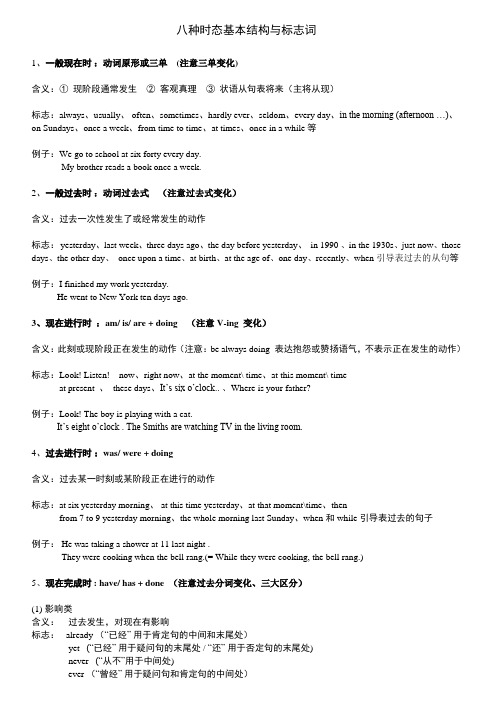
八种时态基本结构与标志词1、一般现在时:动词原形或三单(注意三单变化)含义:①现阶段通常发生②客观真理③状语从句表将来(主将从现)标志:always、usually、 often、sometimes、hardly ever、seldom、every day、in the morning (afternoon …)、on Sundays、once a week、from time to time、at times、once in a while等例子:We go to school at six forty every day.My brother reads a book once a week.2、一般过去时:动词过去式(注意过去式变化)含义:过去一次性发生了或经常发生的动作标志: yesterday、last week、three days ago、the day before yesterday、in 1990 、in the 1930s、just now、those days、the other day、once upon a time、at birth、at the age of、one day、recently、when引导表过去的从句等例子:I finished my work yesterday.He went to New York ten days ago.3、现在进行时:am/ is/ are + doing (注意V-ing 变化)含义:此刻或现阶段正在发生的动作(注意:be always doing 表达抱怨或赞扬语气,不表示正在发生的动作)标志:Look! Listen! now、right now、at the moment\ time、at this moment\ timeat present 、these days、It’s six o’clock..、Where is your father?例子:Look! The boy is playing with a cat.It’s eight o’clock . The Smiths are watching TV in the living room.4、过去进行时:was/ were + doing含义:过去某一时刻或某阶段正在进行的动作标志:at six yesterday morning、 at this time yesterday、at that moment\time、thenfrom 7 to 9 yesterday morning、the whole morning last Sunday、when和while引导表过去的句子例子: He was taking a shower at 11 last night .They were cooking when the bell rang.(= While they were cooking, the bell rang.)5、现在完成时 : have/ has + done (注意过去分词变化、三大区分)(1)影响类含义:过去发生,对现在有影响标志:already (“已经”用于肯定句的中间和末尾处)yet (“已经”用于疑问句的末尾处 / “还”用于否定句的末尾处)never (“从不”用于中间处)ever (“曾经”用于疑问句和肯定句的中间处)just (“刚刚”用于中间处)before ("之前" 用于句尾)once/ twice/ three times...例子:I have just cleaned my clothes. 我刚洗过衣服。
时态的标志词

时态的标志词:时间状语。
1一般现在时:always/usually/often/sometimes/hardly ever/hardly/never every dayonce a week /twice a week 提问how oftenIn the morning/afternoon/e evening/ on Sundaysif till until unless when as soon as2一般过去时yesterday the day before yesterday =the other day前a few minutes agojust now 刚才last Sunday /last week this morning often/…+过去时间on Sunday on Monday3一般将来时tomorrow/ 明天the day after tomorrow后天next year 明年/ next Sunday in a few days /in two days(How soon)in the future 将来before long 不久= soon this evening 今晚by the end of this term4.过去将来said /told ------tomorrow/ the next week.5.现在进行时now = at the moment= at this time 就在现在at present 目前these days 这些天look, listen It’s six now6.过去进形时then =at the time 在那时this time yesterday昨天的这个时候from 7to eight last night at five yesterday昨天5点7.现在完成时1)just 刚刚already已经yet(问,否)还never 从不ever 疑问before以前rencetly最近2)twice /three times how many times ( have been to )3)for /since 过完since +从句+p.4)sofar 目前in the last few years 最近几年for years 数年8.过去完成时by that time 到那个时候by the end of last week 到上周末She said hHe told +3.现在进行时:am/is/are working 4过去进行时:was/were working5.一般将来时will/shall/is,am ,are going to work6.过去将来时:would work/was/were going to7.现在完成时has/have+worked 8过去完成时had worked现在进行完成时:has/have been workinghall/is,am ,are going to work过去进行时:was/were workingShall I/we… ? shall 只能与I/we 连用被动语态重点考:一般现在:am/is /are done一般过去:was/were done一般将来:will be+done1._____ you______ (clean) the room now? No, I____2._______ you ____(clean) the room every day.? Yes ,______3.I’m _________ (watch)4.Is Jim _______ (do) his homework? Yes,_____.5.Lilly and Lucy __________-(clean).now6.She ___________ (not read) now. She _________(do) her homework7.Loo k!They _________ (take)photos .8.Look !The cat _________(run) up the tree9.Listen!Who_________ (sing).10.Listen!The birds_________(sing)11.It’s six o’clock now We ________(have) dinner at home.12._____your father and mother _______(read)books/yes , ______13.Your friends ________(wait) for you.now.情态动词should /can / may / must +doneI. 句型转换1. The children had a good time in the park.否定句:__________________________________________一般疑问句:________________________________________对划线部分提问:____________________________________2. There were about nine hundred people at the concert.(音乐会) 否定句:__________________________________________一般疑问句:________________________________________ 对划线部分提问:____________________________________ 3. There was only one problem.否定句:__________________________________________ 一般疑问句:________________________________________ 肯定/否定回答:____________________________________ 4. Ann did her homework yesterday evening.否定句:__________________________________________ 一般疑问句:________________________________________ 对划线部分提问:____________________________________ 5. Last week I read an English book.否定句:__________________________________________ 一般疑问句:________________________________________ 肯定/否定回答:____________________________________ 对划线部分提问:____________________________________ 6. My brother was in the park just now.否定句:__________________________________________ 一般疑问句:________________________________________ 肯定/否定回答:____________________________________ 对划线部分提问:____________________________________7. She had some bread for lunch today.否定句:__________________________________________一般疑问句:________________________________________肯定/否定回答:____________________________________对划线部分提问:____________________________________8. They read English last night.否定句:__________________________________________一般疑问句:________________________________________肯定/否定回答:____________________________________对划线部分提问:____________________________________、写出下列动词的三单现、过去式和现在分词go ______ _______ _______ enjoy _______ _______ ________buy ______ ______ _______ eat______ _______ _______get _______ _______ _______ walk ________ _______ ________take______ ______ ______ dance_______ ________ _______write _______ ______ ______ run______ _______ _______swim_______ _______ _______ find _______ _______ _______begin______ ______ ______ eat ______ _______ ______play ______ ______ _______ study ______ ______ ________III. 用所给词的适当形式填空。
常见八种时态标志词
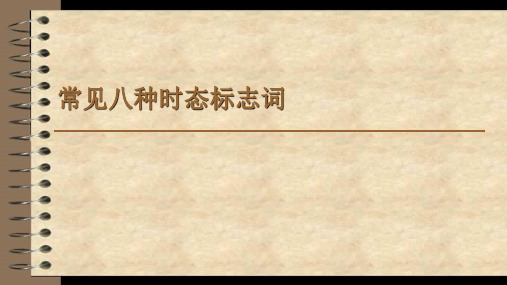
5.一般将来时用will do/be going to do. 标志词:tomorrow,tomorrow. morning,in the future, next week , next Sunday,in+一段时间, soon=right=at once很快,立刻.
6.过去将来时:would do 没有什么标志词,通常用在 从句里。
I didn't know if he would come.
7.现在完成时 has/have done 标志词:already, yet,ever曾经,never从未,just刚刚(与现
在有关的模糊过去时间),before,in the past 5 years, so far ,up to now, two times,for+时间段, since+时间点或从句 8.过去完成时 had done 标志词:by/by the end of+过去时间,by the year 2010....
2.现在进行时am/is /are+doing形式。 标志词:now,at this time, at present,句首有Look!,
Listen!Hurry!等警示语
3.一般过去时用动词的过去式did 标志词有:yesterday, last week , last month, last year, 时间段+ago,two years ago,in 1979,the day before yesterday,just now=a moment ago刚才(与现在无关的明 确过去动词原形do或第三人称单数does形式。
英语八大时态总结一览表
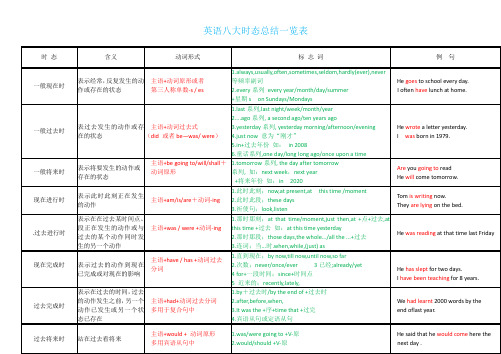
3.连词;当...时.when,while,(just) as
Hewas readingat that timelast Friday
现在完成时
表示过去的动作到现在已完成或对现在的影响
主语+have / has +动词过去
时态
含义
动词形式
标志词
例句
一般现在时
表示经常,反复发生的动作或存在的状态
主语+动词原形或者
第三人称单数-s / es
1.always,usually,often,sometimes,seldom,hardly(ever),never等频率副词
2.every系列 every year/month/day/summer
Tomis writingnow.
Theyare lyingon the bed.
.过去进行时
表示在在过去某时间点、段正在发生的动作或与过去的某个动作同时发生的另一个动作
主语+was / were +动词-ing
1.那时那刻;at that time/moment,just then,at +点+过去,at this time +过去 如:at this time yesterday
2....ago系列, a second ago/ten years ago
3.yesterday系列, yesterday morning/afternoon/evening
4.just now 意为“刚才”
5.in+过去年份 如: in 2008
6.童话系列,one day/long long ago/once upon a time
中高考 英语常考8种英语时态的标志词
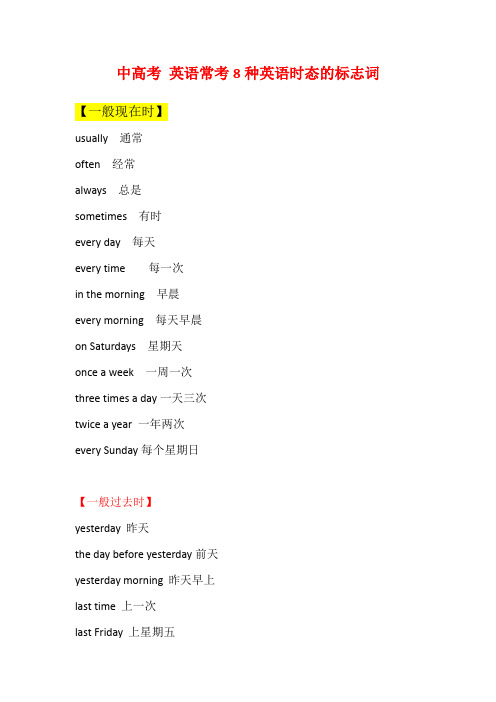
中高考英语常考8种英语时态的标志词【一般现在时】usually 通常often 经常always 总是sometimes 有时every day 每天every time 每一次in the morning 早晨every morning 每天早晨on Saturdays 星期天once a week 一周一次three times a day一天三次twice a year 一年两次every Sunday每个星期日【一般过去时】yesterday昨天the day before yesterday前天yesterday morning昨天早上last time上一次last Friday上星期五last term上学期last year去年一段时间+ago多久以前just now刚刚a moment ago刚刚in19901990atthe age of6六岁的时候one day有一天long long ago很久以前once upon a time从前in the past过去【一般将来时】tomorrow明天the day after tomorrow后天tomorrow morning明天早上next time下一次next Friday下个星期五next term下个学期next month下个月in+一段时间多久以后in+一段时间’s+timesoon=right away=at once by the end of+将来时间【现在进行时】now 现在look 看listen 听at this time 此时at this moment 此刻at present 现在these days 这些天this week 这周yesterday evening昨天晚上【现在完成时】already早已,已经,先前yet还,但是,已经just刚才never从不ever曾经before以前up to now目前为止for+一段时间since+过去某一时间【过去进行时】at that timeat that moment【过去将来时】the following month the next timethe next Fridaythe next term【过去完成时】(1) by +过去时间点by the timeby thenby last yearby the end of last year (2) before+过去时间点(3) up till +过去时间点up till thenup until last morning。
英语8种时态归纳表
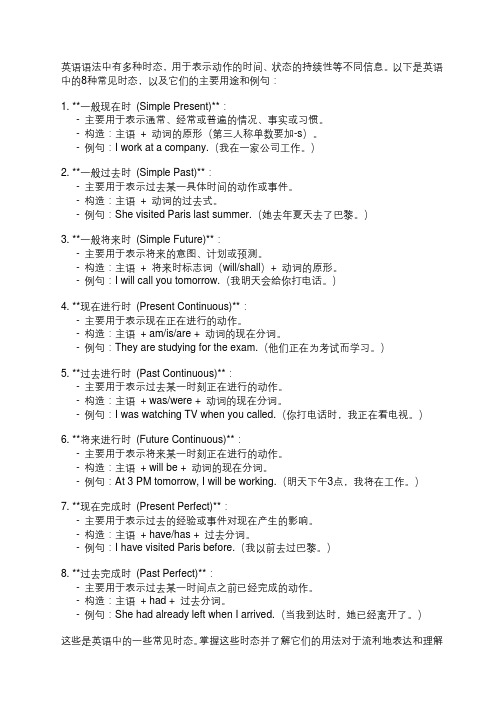
英语语法中有多种时态,用于表示动作的时间、状态的持续性等不同信息。
以下是英语中的8种常见时态,以及它们的主要用途和例句:1. **一般现在时(Simple Present)**:- 主要用于表示通常、经常或普遍的情况、事实或习惯。
- 构造:主语+ 动词的原形(第三人称单数要加-s)。
- 例句:I work at a company.(我在一家公司工作。
)2. **一般过去时(Simple Past)**:- 主要用于表示过去某一具体时间的动作或事件。
- 构造:主语+ 动词的过去式。
- 例句:She visited Paris last summer.(她去年夏天去了巴黎。
)3. **一般将来时(Simple Future)**:- 主要用于表示将来的意图、计划或预测。
- 构造:主语+ 将来时标志词(will/shall)+ 动词的原形。
- 例句:I will call you tomorrow.(我明天会给你打电话。
)4. **现在进行时(Present Continuous)**:- 主要用于表示现在正在进行的动作。
- 构造:主语+ am/is/are + 动词的现在分词。
- 例句:They are studying for the exam.(他们正在为考试而学习。
)5. **过去进行时(Past Continuous)**:- 主要用于表示过去某一时刻正在进行的动作。
- 构造:主语+ was/were + 动词的现在分词。
- 例句:I was watching TV when you called.(你打电话时,我正在看电视。
)6. **将来进行时(Future Continuous)**:- 主要用于表示将来某一时刻正在进行的动作。
- 构造:主语+ will be + 动词的现在分词。
- 例句:At 3 PM tomorrow, I will be working.(明天下午3点,我将在工作。
英语八大时态标志词及结构表
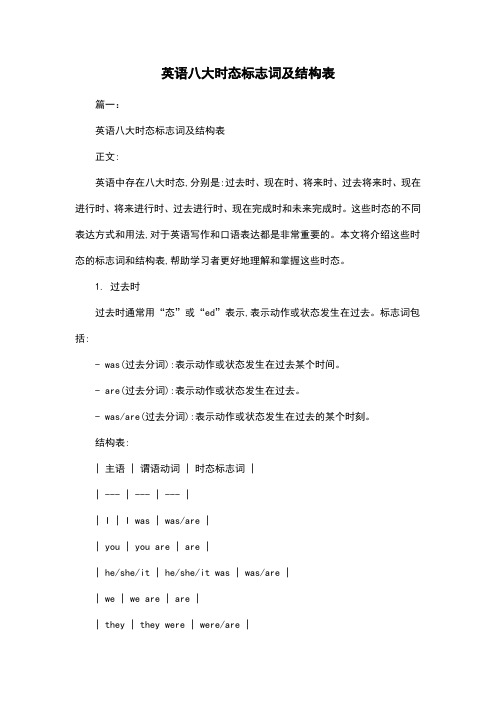
英语八大时态标志词及结构表篇一:英语八大时态标志词及结构表正文:英语中存在八大时态,分别是:过去时、现在时、将来时、过去将来时、现在进行时、将来进行时、过去进行时、现在完成时和未来完成时。
这些时态的不同表达方式和用法,对于英语写作和口语表达都是非常重要的。
本文将介绍这些时态的标志词和结构表,帮助学习者更好地理解和掌握这些时态。
1. 过去时过去时通常用“态”或“ed”表示,表示动作或状态发生在过去。
标志词包括:- was(过去分词):表示动作或状态发生在过去某个时间。
- are(过去分词):表示动作或状态发生在过去。
- was/are(过去分词):表示动作或状态发生在过去的某个时刻。
结构表:| 主语 | 谓语动词 | 时态标志词 || --- | --- | --- || I | I was | was/are || you | you are | are || he/she/it | he/she/it was | was/are || we | we are | are || they | they were | were/are |2. 现在时现在时通常用“态”或“ing”表示,表示动作或状态现在正在进行。
标志词包括:- am/is(现在分词):表示动作或状态现在正在进行。
- are(现在分词):表示动作或状态现在正在进行。
- was/are(现在分词):表示动作或状态现在正在进行。
结构表:| 主语 | 谓语动词 | 时态标志词 || --- | --- | --- || I | I am | am/is || you | you are | are || he/she/it | he/she/it is | is/are || we | we are | are || they | they are | are |3. 将来时将来时通常用“态”或“ing”表示,表示动作或状态将来会发生。
标志词包括:- will(将来分词):表示动作或状态将来会发生。
- 1、下载文档前请自行甄别文档内容的完整性,平台不提供额外的编辑、内容补充、找答案等附加服务。
- 2、"仅部分预览"的文档,不可在线预览部分如存在完整性等问题,可反馈申请退款(可完整预览的文档不适用该条件!)。
- 3、如文档侵犯您的权益,请联系客服反馈,我们会尽快为您处理(人工客服工作时间:9:00-18:30)。
常用英语8种时态这64个标志词就够了一般现在时
always,ususlly,often,sometimes
never ,seldom很少(否定词)
every day/week/month/year/morning/evening/night
each day/week/month/year/morning/evening/night
once a week每周一次,
twice a month每月两次,
three times a year一年三次
in the morning 早晨
on Saturdays 周六
every morning 每天早晨
every Saturday 每个周六
一般过去时
yesterday昨天
the day before yesterday前天,
two days ago两天前
last day/night/week/month/year 昨天/夜;上周/月;去年
in 1990 在1990年
just now刚才
at the age of five五岁时
once upon a time 从前
in the past 过去
a moment ago 刚刚
long long ago 很久以前
in 1988 1988年
last Friday 上周五
一般将来时
tomorrow 明天
the day after tomorrow 后天
tomorrow morning 明天早上
next time 下次
next Friday/term/month/year
in+一段时间
soon/right away
in the future
现在进行时
now 现在
look 看
listen 听
at this time/moment此时
these days 这些天
at present 现在
现在完成时
already/yet
just
never
ever
for+一段时间
since+时间一点
so far/up to now 到目前为止
in the past three years 在过去3年里过去完成时
by+过去时间点
by the time
by then
by the end of last year
before+过去时间点
up till+过去时间点
up till then
过去进行时
at that time
at that moment
yesterday evening
过去将来时
the following month
the next time
the next friday
the next term。
